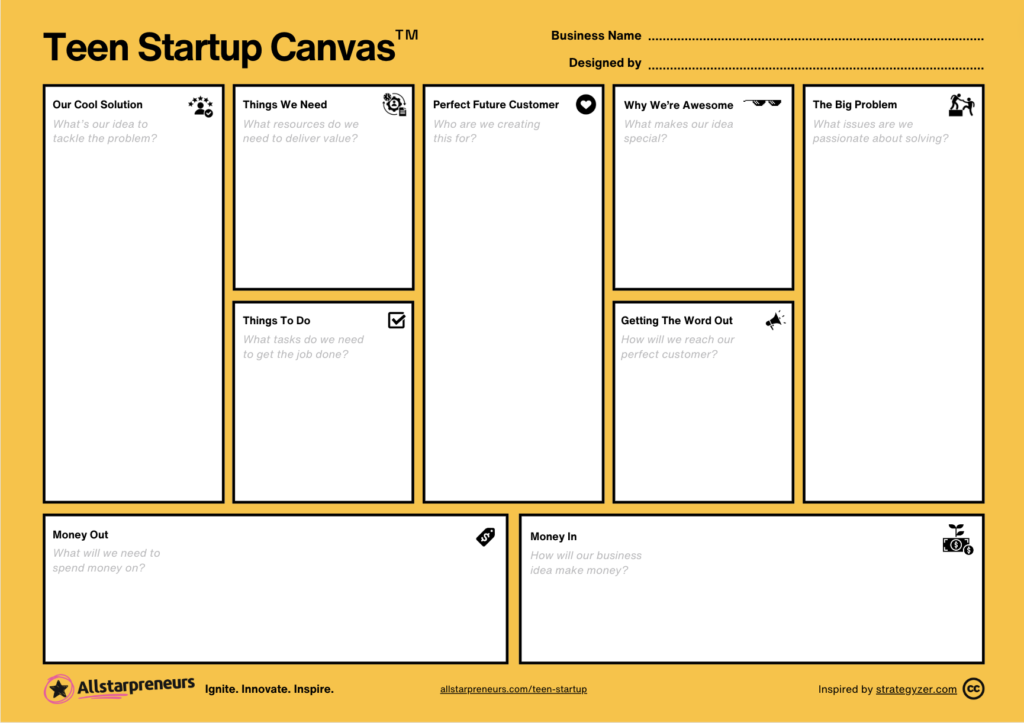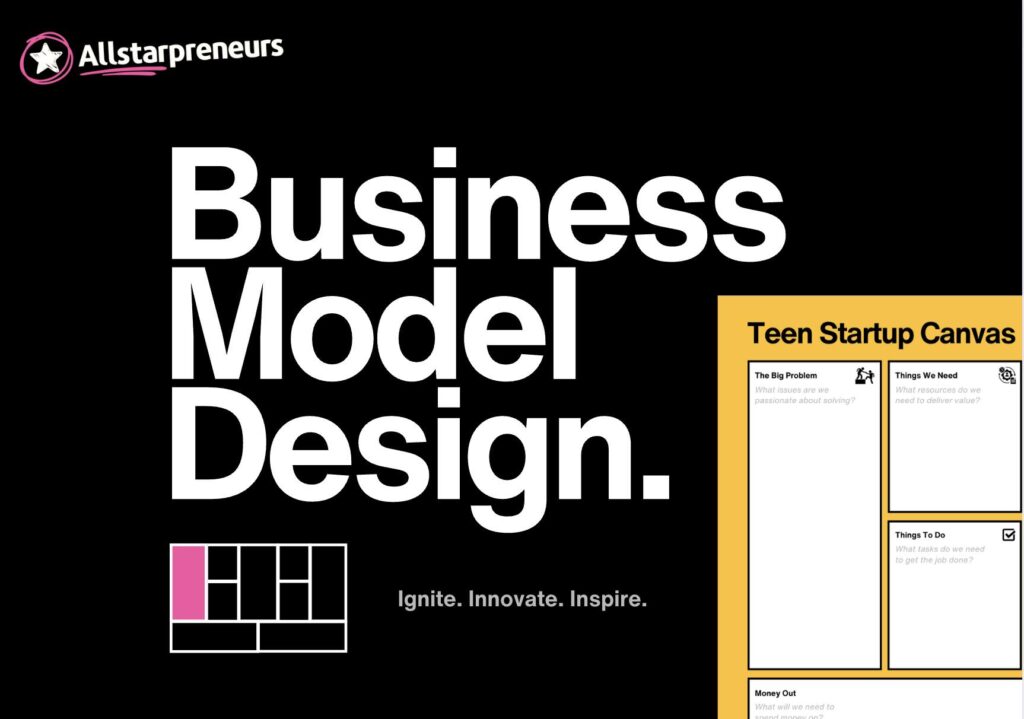In this comprehensive guide, we aim to empower young entrepreneurs to transform ideas into a viable business using the Teen Startup Canvas™. Understanding business model design is crucial, offering a structured framework to transform ideas into sustainable ventures and our canvas, adapted by Steve Mullen, from the Business Model Canvas & Lean Canvas. With insightful strategies and practical examples, we guide you through identifying customers’ needs, ideating solutions, and designing a compelling business model.
So, are you ready to embark on this exciting journey? Let’s begin!
What is a business model and why is it important for young entrepreneurs to understand?
A business model is the fundamental blueprint that outlines how a company or startup plans to create, deliver, and capture value. It’s the core logic that drives a business’s operations, revenue streams, and profitability. For young entrepreneurs, understanding business model design is crucial, as it provides a structured framework to transform their ideas into sustainable ventures.
Business models are important for several reasons. First, they help entrepreneurs clearly articulate their value proposition – what unique benefits they are offering to customers and why those customers would be willing to pay. Second, a well-designed business model identifies the key resources, activities, and partnerships required to deliver that value. Third, it outlines the cost structure and revenue streams that will make the venture financially viable.
By grasping these core elements, teenage founders can better assess the feasibility of their ideas, identify potential roadblocks, and make informed decisions about how to allocate their limited time and resources. A thoughtful business model also serves as a roadmap for scaling the venture and adapting to changing market conditions.
How can teenagers identify a problem worth solving and develop a viable business idea?
The starting point for any successful business is identifying a real problem that customers are willing to pay to have solved. For young entrepreneurs, this process begins with keen observation and empathy. What challenges do you and your peers face in your daily lives? What unmet needs or frustrations do you notice in your community?
Once you’ve identified a promising problem space, the next step is to deeply understand the target customer. Who exactly is experiencing this problem? What are their specific pain points, goals, and behaviours? Conducting customer interviews, surveys, and market research can provide invaluable insights to inform your business idea.
With a clear understanding of the problem and customer, you can then start ideating potential solutions. Brainstorm as many ideas as possible, then critically evaluate them based on criteria like feasibility, scalability, and potential profitability. Don’t be afraid to get creative and think outside the box – some of the most successful teen startups have emerged from unconventional ideas.
Ultimately, the goal is to develop a viable business concept that addresses a genuine customer need in a unique and compelling way. This “problem-solution fit” is the foundation of a strong business model.
Key Elements of the Teen Startup Canvas™: Building a Blueprint for Success
The Teen Startup Canvas™ has been designed by Steve Mullen, founder of Allstarpreneurs and has been adapted from the Lean Canvas & Business Model Canvas. While both predecessors are groundbreaking business planning tools, and used by entrepreneurs all around the world the Teen Startup Canvas has been redesigned to be less formal and more relatable to young entrepreneurs.
The canvas is a strategic management & planning tool that provides a visual framework for describing and designing a company’s value proposition, infrastructure, customers, and finances. For young entrepreneurs, it’s an essential tool for mapping out the core elements of their venture in a clear, structured way.

Here’s a breakdown of each of the components with brief explanation of what they are and how to complete them:
- The Big Problem: Identifying the main issue or challenge the business aims to solve. This helps focus the entrepreneurial effort on a specific target.
- Our Cool Solution: Describing the product or service that the business will offer to solve the identified problem, showcasing the innovation or unique approach.
- Perfect Future Customer: Defining the ideal customer for the product or service. This includes understanding who they are, their behaviors, needs, and how the product fits into their lives.
- Why We’re Awesome: Highlighting what makes the business or product unique and why it stands out in the market. This could involve unique selling points, competitive advantages, or innovative aspects.
- Getting The Word Out: Planning the marketing and communication strategies that will be used to reach the target audience. This includes channels and methods of promotion to create awareness and attract customers.
- Things We Need: Listing all the resources required to start and run the business. This includes physical items, technology, human resources, and any other essential needs.
- Things To Do: Outlining the key tasks and activities that need to be completed to start and maintain the business. This helps in organizing the process and ensuring all critical steps are accounted for.
- Money In: Detailing how the business will generate revenue. This includes pricing strategies, sales tactics, and any other methods for earning money.
- Money Out: Identifying all expected expenses and costs associated with running the business. This helps in financial planning and budget management.
These components are designed to be both a checklist and a roadmap for young entrepreneurs, helping them to think through the crucial aspects of starting and running a business.
By systematically working through each of these building blocks, young entrepreneurs can develop a comprehensive, interconnected understanding of their business model. This clarity is invaluable for securing funding, attracting talent, and guiding strategic decision-making.
How can young entrepreneurs test and validate their business model hypotheses?
Developing a robust business model is an iterative process of testing and validation. As teenage founders, it’s crucial to adopt a lean, experimental mindset and continuously gather feedback from potential customers to refine your assumptions.
One effective approach is the “build-measure-learn” cycle of the Lean Startup methodology. This involves rapidly prototyping your value proposition, testing it with real users, and then using the insights to make informed pivots or persevere with your current model.
Some key validation techniques include:
- Customer Interviews: Conduct in-depth interviews to deeply understand your target customers’ pain points, needs, and reactions to your proposed solution.
- Minimum Viable Products (MVPs): Create basic, low-cost prototypes of your product or service and get them in the hands of potential customers to gauge their interest and feedback.
- Landing Pages and Signup Forms: Test the appeal of your value proposition by creating a simple landing page and measuring metrics like click-through and conversion rates.
- Concierge Tests: Manually fulfill customer requests to validate demand and gather insights before automating your processes.
- A/B Testing: Experiment with different versions of your product, pricing, or marketing messaging to identify the most effective approaches.
The goal is to quickly and cost-effectively validate (or invalidate) your key business model assumptions before investing significant time and resources. This “fail fast, fail cheap” mentality allows young entrepreneurs to iterate and refine their models until they find a winning formula.
What are some common business model patterns and how can they be adapted for teen startups?
As you design your business model, it can be helpful to draw inspiration from successful models used by other companies. Some common patterns include:
- Freemium: Offering a basic version of your product or service for free, while charging for premium features or functionality.
- Subscription: Providing ongoing access to your offering in exchange for a recurring payment, often with tiered pricing.
- Marketplace: Connecting buyers and sellers, and taking a commission or fee for facilitating the transactions.
- Razor and Blade: Selling a core product at a low cost (or even giving it away) to drive demand for complementary, higher-margin offerings.
- Multi-Sided Platform: Creating value by facilitating interactions between two or more interdependent groups, such as consumers and producers.
When adapting these models for teen startups, the key is to focus on simplicity, scalability, and alignment with your target customers’ needs and behaviors. For example, a freemium model could work well for a productivity app aimed at students, where the core features are free but advanced tools are available for a monthly subscription.
Alternatively, a teen-focused marketplace platform could connect local service providers (like lawn mowing or dog walking) with customers in the community. Or a razor-and-blade model could involve selling a basic hardware device at cost, while generating recurring revenue from complementary digital content or accessories.
Conclusion
The most important thing is to choose a business model that fits your passion & purpose. By understanding these 9 components of ANY business model and adapting them creatively, as a young entrepreneur, you can increase your chances of building a sustainable and scalable venture.
Good luck!


